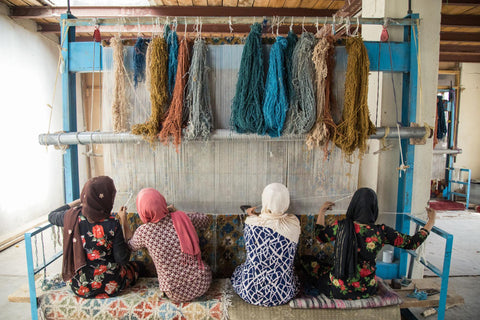 Handmade Afghan rugs are not merely decorative floor coverings; they embody a rich cultural heritage, intricate craftsmanship, and stories of empowerment. This article delves into the fascinating world of Afghan rugs, exploring the natural dye process, the women behind their creation, and the captivating patterns and motifs that make them truly extraordinary. Discover the allure of these rugs and gain insight into the remarkable journey they undertake from loom to living room.
Handmade Afghan rugs are not merely decorative floor coverings; they embody a rich cultural heritage, intricate craftsmanship, and stories of empowerment. This article delves into the fascinating world of Afghan rugs, exploring the natural dye process, the women behind their creation, and the captivating patterns and motifs that make them truly extraordinary. Discover the allure of these rugs and gain insight into the remarkable journey they undertake from loom to living room.
The Natural Dye Process: One of the distinguishing features of handmade Afghan rugs is the use of natural dyes derived from plant sources, resulting in earthy and vibrant colors. Traditional dyeing techniques involve extracting hues from plants, fruits, and minerals, ensuring a harmonious connection between nature and artistry. Madder root, walnut husks, pomegranate skin, and indigo leaves are among the natural ingredients employed, infusing the rugs with organic beauty and subtle variations in shade. These natural dyes not only create a unique aesthetic but also contribute to the rug's longevity, as they age gracefully over time.
Women Empowerment in Rug Weaving: The art of rug weaving has provided a source of empowerment for Afghan women for generations. Many rural communities rely on rug weaving as a means of livelihood, enabling women to support their families and gain financial independence. In recent years, initiatives focused on women's empowerment have further amplified their role in rug production, fostering skill development, fair wages, and safe working conditions. By investing in handmade Afghan rugs, you contribute to this empowerment, creating a positive impact on the lives of these talented women weavers.
Patterns and Motifs: Afghan rugs showcase a rich tapestry of patterns and motifs, each with its symbolic significance and cultural heritage. Here are a few noteworthy examples:
a) Gul-e-Bulbul (Nightengale Flower): This motif represents rebirth and is often featured in floral patterns, symbolizing the beauty and resilience of nature.
b) Eslimi: Inspired by intricate Islamic geometric designs, this pattern consists of interlocking shapes and embodies unity and infinity.
c) Tree of Life: A recurring motif in Afghan rugs, the Tree of Life represents fertility, growth, and the interconnectedness of all living things.
d) War Rugs: Depicting scenes from Afghan history, including conflicts and resistance, these rugs serve as artistic expressions and narratives of resilience.
e) Baluch Rugs: Known for their geometric patterns and rich red hues, Baluch rugs often feature tribal motifs and reflect the nomadic heritage of the Baluch people.
Conclusion: Handmade Afghan rugs are not just pieces of art but gateways into a world of tradition, empowerment, and intricate craftsmanship. From the natural dye process that infuses the rugs with organic beauty to the women who weave them with skill and determination, every aspect of these rugs tells a captivating story. The patterns and motifs embody cultural heritage and symbolism, while your support for Sama Rugs contributes to women's empowerment and the preservation of a time-honored craft. Embrace the artistry of handmade Afghan rugs and enrich your living space with beauty, meaning, and a connection to a vibrant and resilient culture.
We are Afghan carpet experts (Art Doku Halı) and truly loved your article. It’s concise yet comprehensive, perfectly fitting into a full page, and covers everything so well. We’d love to include it in our Afghan carpets product catalog. Once our catalog is ready, we’ll make sure to send you a PDF copy. Thank you so much for this wonderful blog content!